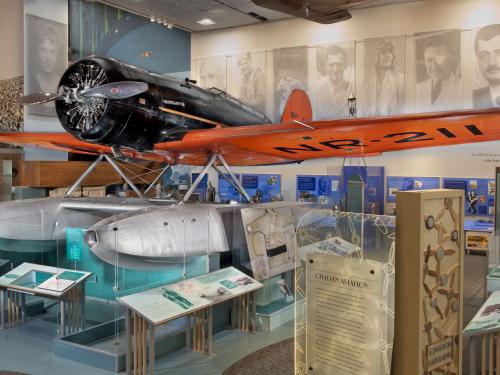
Stories of daring, stories of technological feats, stories of prevailing against the odds ... these are the stories we tell at the National Air and Space Museum. Dive in to the stories below to discover, learn, and be inspired.
Showing 671 - 680 of 698

April 26, 2010
Sometimes seemingly ordinary people become extraordinary by staying remarkably calm and capable in a crisis. The crew of US Airways Flight 1549 performed exceptionally on January 15, 2009, when their Airbus A320 jetliner became disabled over New York City after flying through a flock of geese moments after they took off from LaGuardia Airport. Capt. Chesley B. “Sully” Sullenberger and First Officer Jeffrey B. Skiles masterfully guided the powerless aircraft to an emergency “landing” on the Hudson River.

March 29, 2010
National Air and Space Museum staff are hard at work renovating the Pioneers of Flight gallery, scheduled to open later this year. It will be filled with the fascinating stories of the colorful personalities of early aviation, including Jimmy Doolittle, Bessie Coleman, Amelia Earhart, and Charles and Anne Lindbergh, plus Robert Goddard and other rocket pioneers. One of the featured artifacts is the newly cleaned Lockheed Sirius Tingmissartoq, the dual cockpit plane that carried Charles and Anne Lindbergh on their exploratory trips across several continents in 1931 and 1933. The trips made headlines and were the basis for two popular books written by Anne, North to the Orient and Listen, the Wind! Cognizant of their place in history, the Lindberghs carefully saved the majority of items they packed for the trips. Now after several decades in storage, many will be on display for the first time.

January 11, 2010
I was perusing that perennial bestseller, the FAA’s “Aeronautical Information Manual,” the other night, and ran across an intriguing reference to code beacons and course lights. Code beacons, in general, flash identifying information in Morse code; coded course lights are used with rotating beacons of the Federal Airway System, are highly directional, and are paired back-to-back pointed along the airway. What interested me was the appended note:

December 05, 2009
While hunting for images of navigators in World War II, a series appeared which, although completely distant from my topic, still grabbed my attention. They were pictures of a military funeral. These pictures were unique, however, because they were not showing the solemn burial of a soldier, airmen, or sailor; they were showing the burial of a unit mascot.

November 20, 2009
Add wildlife conservation to the growing list of special jobs that only ultralight aircraft can do. Right now, a volunteer group called Operation Migration is using Cosmos Phase II ultralights to lead a flock of endangered whooping cranes on the first migration of their young lives, from Wisconsin to Florida. The excellent control and performance of the ultralight at speeds much slower than more conventional aircraft makes this possible. After months of intensive training, the Operation Migration staff have trained the birds to follow the ultralight as though it were another crane.

November 06, 2009
The Smithsonian acquired its Jenny in 1918, only days after the Armistice ending World War I. The airplane was re-covered in the 1920s, and remains completely original from that time. The Museum's Jenny is one of the true jewels of the collection. It has a particular place of pride in my curatorial responsibilities, and the whole museum staff has a great soft spot in our hearts for our Jenny. When the opportunity to put it on display in the Mall museum presented itself with the building of the new commercial aviation exhibition, America by Air, a few years ago, I was delighted to make it available to the curator of the new gallery. When the exhibition opened in 2007, it was a great success and the Jenny looked fabulous on its perch, drawing visitors toward America by Air. A museum favorite finally was center stage for all to enjoy.

October 31, 2009
Cecil “Teddy” Kenyon (1905-1985), on the left, and her husband Theodore "Ted" Whitman Kenyon (1899-1978) were a flying family – when they weren’t trick-or-treating, as this 1940s photograph from their collection in the Museum’s Archives Division shows.

October 28, 2009
At this time of year when apparitions and fanciful creatures stroll sidewalks in search of treats, it’s a good time to remember that not all aircraft are what they seem.

October 21, 2009
The afternoon of October 15, 2009 was one of those rare moments when Americans from coast-to-coast were riveted to their television sets by a news story unfolding in real time. Six year old Falcon Heene was reported to be trapped aboard a helium balloon floating across the Colorado landscape at 7000 feet. The image on the screen was surreal, a strange craft looking like a cross between a Mylar grocery store balloon and a flying saucer, with a small circular structure on the bottom that appeared to be just large enough to house a small child. When the balloon came naturally to earth after a fifty mile flight, however, the boy was not aboard.
October 17, 2009
As mentioned in Dom Pisano’s recent post “From Collecting to Curating,” six interns, including myself, and two volunteers (with our supervisor, enough for a baseball team!) photographed, scanned and catalogued much of the museum’s collection of over 1,300 posters at the Paul E. Garber Facility's collections processing unit this summer. It sounds like a lot of posters, but you may not have seen any of them, unless you have a great memory of advertisements you glimpsed in airports over the years while running to catch your plane.